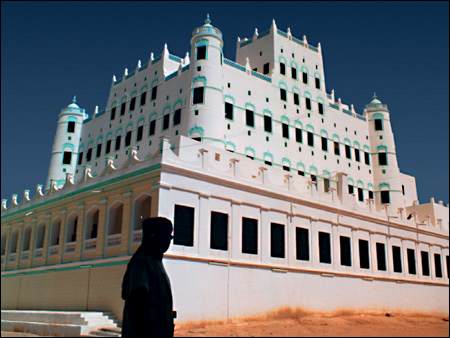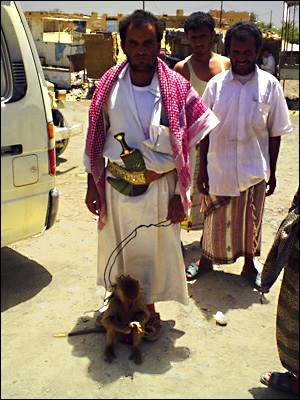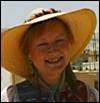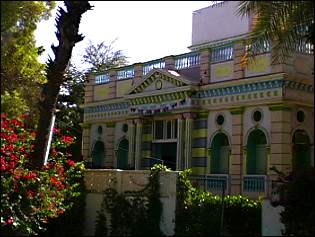
|
Seyun ©ViewZone Expedition 2001
Hadhramout is a province in South Yemen. It is a spectacular lush, fertile spot and the favorite destination of many visitors to this mystical land. Hadhramout has its own music and its own style of almost everything! Colors are bright and the food is spicy. Pre-Islamic ruins and ancient mosques abound.
A wadi is a river, usually surrounded by a canyon. In Yemen, wadis can often be dry and rocky, seeing water only when the rains come in the late spring and early fall. Most of the time the rivers remain underground, hiding from the scorching sun. Vegetation thrives along the underground wadis and many major villages, like Seyun, are located along these dry river beds.
Once a major stop on the Incense Route, Seyun served as the capital of the Kathiri Sultanate for five hundred years, from 1400 to 1967 AD, allowing it to become the largest city in Wadi Hadhramout. In the city's center the former Imam's palace closely resembled a three tier wedding-cake covered in vanilla icing. It has since been transformed into a museum, complete with a spacious outdoor performance stage. Fresh-air concerts in the courtyard of Seyun's historic Sultan's Palace Museum are a lovely way to spend an evening under the Arabian stars.

All around this famous museum there were little suqs and shops serving shai. Supplies were easily found in the rows of shops surrounding the museum. Batteries, film, razors... If you couldn't find what you were looking for in one of the little shops, there was always a suq near by where you could. Gary was searching for a pair of sandals and I wanted AA batteries. With little difficulty, we found both. Lingering by the Toyota, my attention was caught by a young man gesturing for me to approach. "I'll be right back," I told the boys and went over to see what the man had to show me. A strange barking squeaking sound came from the table beside him. Grinning, he leaned down and pulled back the cloth covering the table to reveal a bright eye-ed and energetic little baboon! |

|
Tarim and Aynat
Tarim is an important historical site for Islam. Many manuscripts have been collected and are studied in the Al- Ahqaf library of this modest town.
The architecture is also significant for it's blending of east Asian and Yemeni design. Some emigrants returned from their travels in Singapore and Indonesia with new ideas and designs which became eloquently integrated into the architecture. |
 Talc-white tombs of learned and highly honored men dot the land. In Aynat, we found the tombs of a family of teachers, one father and six sons. As it was Friday we were unable to wander in among the smooth flat tomb stones of the townspeople buried ad sanctus.
Talc-white tombs of learned and highly honored men dot the land. In Aynat, we found the tombs of a family of teachers, one father and six sons. As it was Friday we were unable to wander in among the smooth flat tomb stones of the townspeople buried ad sanctus. Filming alone on a sandy bank, I was surprised to hear a woman voice. "Gutten-tag," she said. Turning, I found a woman in a large straw hat, holding a camera. "I'm sorry, I don't speak German," I smiled. "Oh! Are you British?" she asked in clear English. "American," I grinned sheepishly. Americans do not have the best reputation, for any number of reasons. Sometimes I wondered what kind of reaction my nationality would arouse. "I am Ingrid," she smiled. I introduced myself and we shook hands. Ingrid was on holiday with her husband and also enjoying her time in Yemen. "And, what are you doing in Yemen?" she asked me. I told her about Viewzone and our fascinating tour. We met many Europeans in Yemen and shared our stories and experiences with many happy tourists. We were surprised that there were so few Americans or Canadians and often were puzzled why this friendly and beautiful land was deemed a dangerous destination by many Western countries.
|

The tombs of the seven teachers; one father and six sons. |

Tarim's Al Qabba Hotel was an oasis in the desert. Pulling through the main gate from the dry valley road, we were not expecting such a beautiful place.
Following a jungle like path we walked along the tropical garden until we arrived at the hotel -- a ginger-bread-house sitting beside a spring-fed swimming pool of cool, crystal clear water.
The water was more than Gary could resist. He waved away his shai, shucked off his shoes and plunged in. Other visitors and guests of the hotel were soon splashing about in the pool with him, lounging on inflatable mattresses and swimming lazy laps. Refreshed, Gary joined us for lunch under the trees, beside the pool.
Fed and cooled down we continued on our way, finally finishing with dinner of traditional Yemeni fare in the airy dining room of the fully modern BMC hotel back in Seyun.
Our next major destination point would be the distant port city of Al Mulkulla. Between Wadi Hadramout and the sea coast we would have a day's and night's travel through Wadi Do'an and over the high flat plateau."Yuh-lay-ahlah! Let's go!"
|
Clickable Map of Yemen
Previous Page ||
ViewZone || --next-->